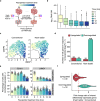Nuclear oligo hashing improves differential analysis of single-cell RNA-seq
- PMID: 35562344
- PMCID: PMC9106741
- DOI: 10.1038/s41467-022-30309-4
Nuclear oligo hashing improves differential analysis of single-cell RNA-seq
Abstract
Single-cell RNA sequencing (scRNA-seq) offers a high-resolution molecular view into complex tissues, but suffers from high levels of technical noise which frustrates efforts to compare the gene expression programs of different cell types. "Spike-in" RNA standards help control for technical variation in scRNA-seq, but using them with recently developed, ultra-scalable scRNA-seq methods based on combinatorial indexing is not feasible. Here, we describe a simple and cost-effective method for normalizing transcript counts and subtracting technical variability that improves differential expression analysis in scRNA-seq. The method affixes a ladder of synthetic single-stranded DNA oligos to each cell that appears in its RNA-seq library. With improved normalization we explore chemical perturbations with broad or highly specific effects on gene regulation, including RNA pol II elongation, histone deacetylation, and activation of the glucocorticoid receptor. Our methods reveal that inhibiting histone deacetylation prevents cells from executing their canonical program of changes following glucocorticoid stimulation.
© 2022. The Author(s).
Conflict of interest statement
C.T. is a SAB member, consultant, and/or co-founder of Algen Biotechnologies, Altius Therapeutics, and Scale Biosciences. One or more embodiments of one or more patents and patent applications filed by the University of Washington may encompass methods, reagents, and the data disclosed in this manuscript. Some work in this study is related to technology described in patent applications. All other authors declare no competing interests.
Figures




Similar articles
-
Data Analysis in Single-Cell Transcriptome Sequencing.Methods Mol Biol. 2018;1754:311-326. doi: 10.1007/978-1-4939-7717-8_18. Methods Mol Biol. 2018. PMID: 29536451
-
Single-Cell RNA Sequencing Analysis: A Step-by-Step Overview.Methods Mol Biol. 2021;2284:343-365. doi: 10.1007/978-1-0716-1307-8_19. Methods Mol Biol. 2021. PMID: 33835452
-
Quality Control of Single-Cell RNA-seq.Methods Mol Biol. 2019;1935:1-9. doi: 10.1007/978-1-4939-9057-3_1. Methods Mol Biol. 2019. PMID: 30758816
-
Data normalization for addressing the challenges in the analysis of single-cell transcriptomic datasets.BMC Genomics. 2024 May 6;25(1):444. doi: 10.1186/s12864-024-10364-5. BMC Genomics. 2024. PMID: 38711017 Free PMC article. Review.
-
Machine learning and statistical methods for clustering single-cell RNA-sequencing data.Brief Bioinform. 2020 Jul 15;21(4):1209-1223. doi: 10.1093/bib/bbz063. Brief Bioinform. 2020. PMID: 31243426 Review.
Cited by
-
Demultiplexing of single-cell RNA-sequencing data using interindividual variation in gene expression.Bioinform Adv. 2024 Jun 8;4(1):vbae085. doi: 10.1093/bioadv/vbae085. eCollection 2024. Bioinform Adv. 2024. PMID: 38911824
References
Publication types
MeSH terms
Substances
Grants and funding
LinkOut - more resources
Full Text Sources
Molecular Biology Databases

